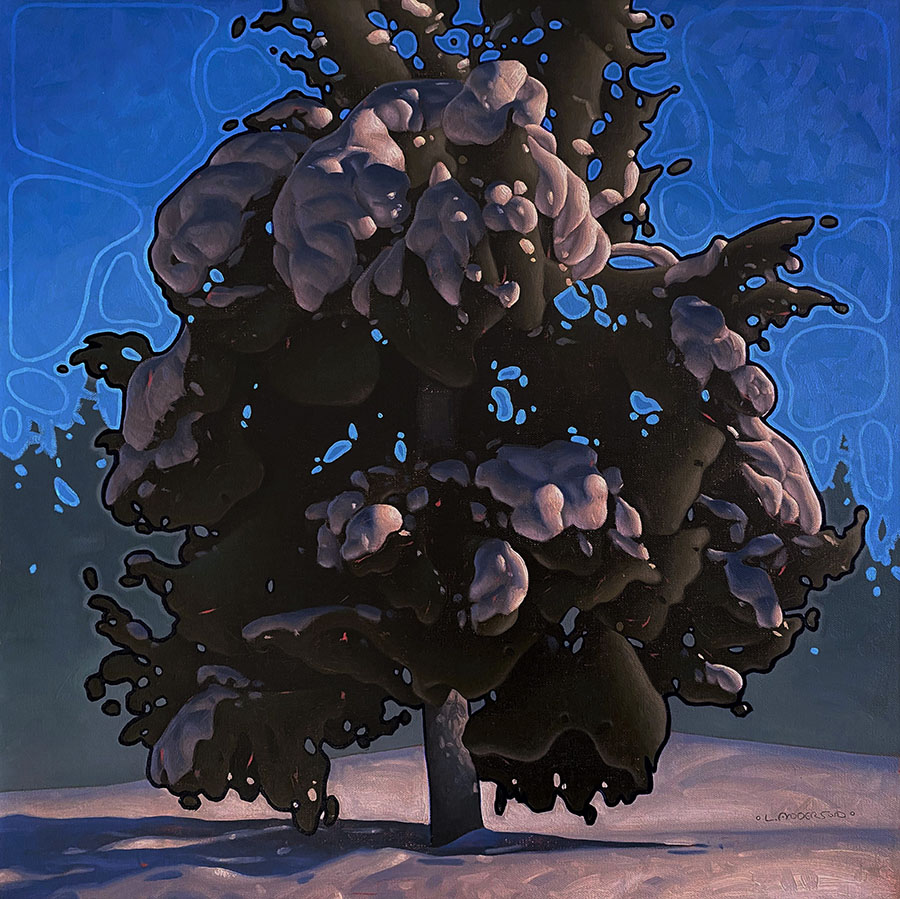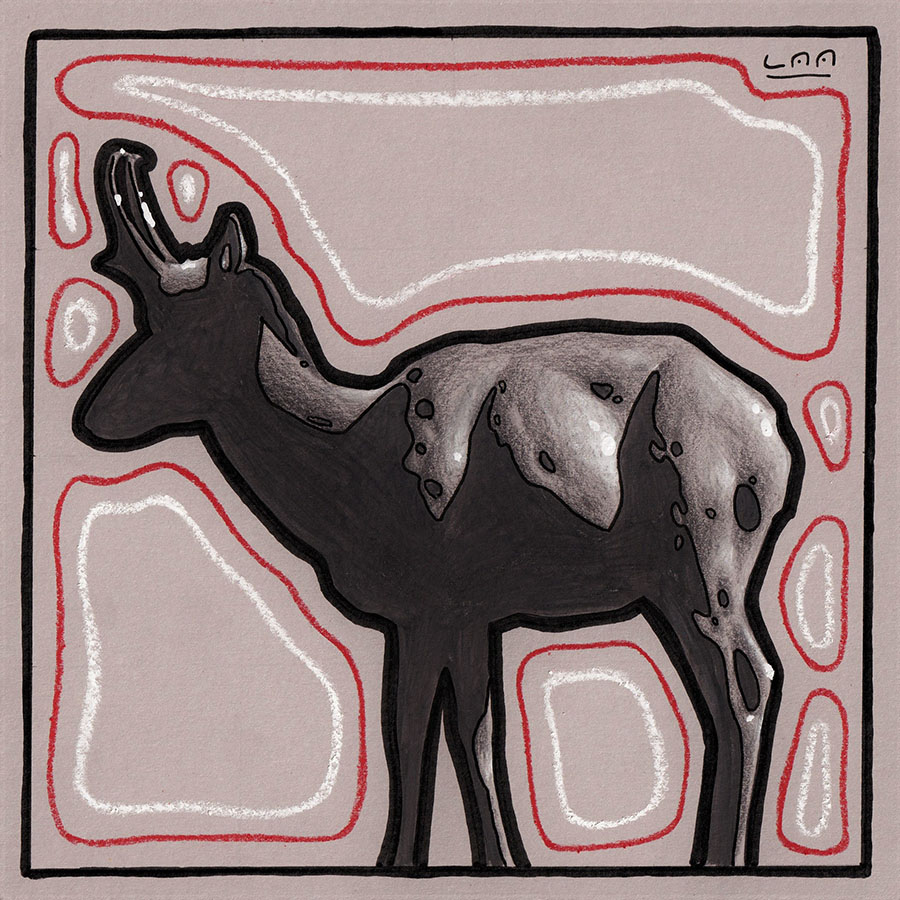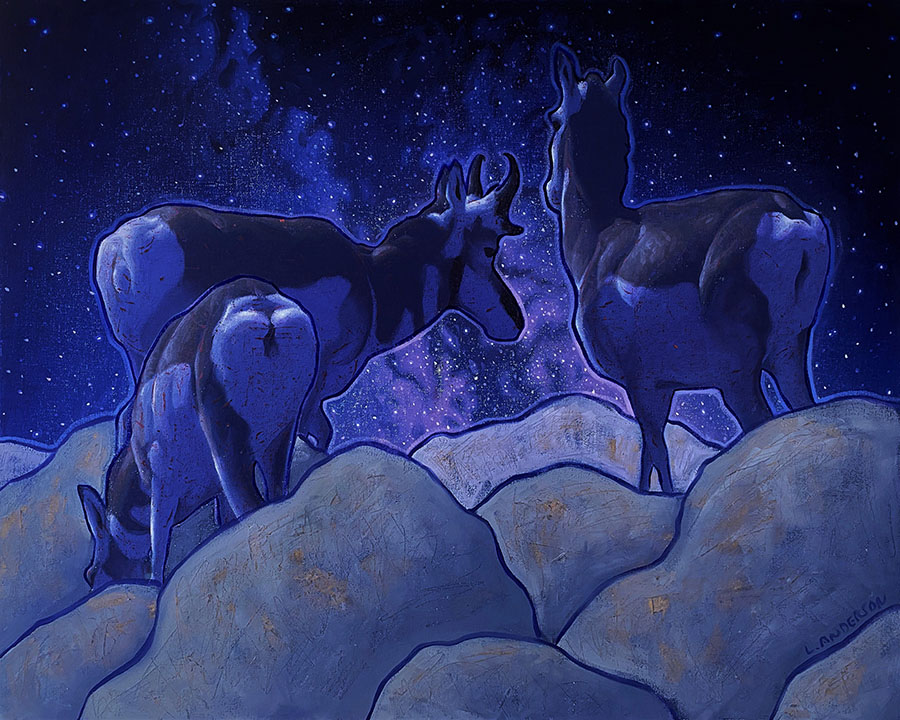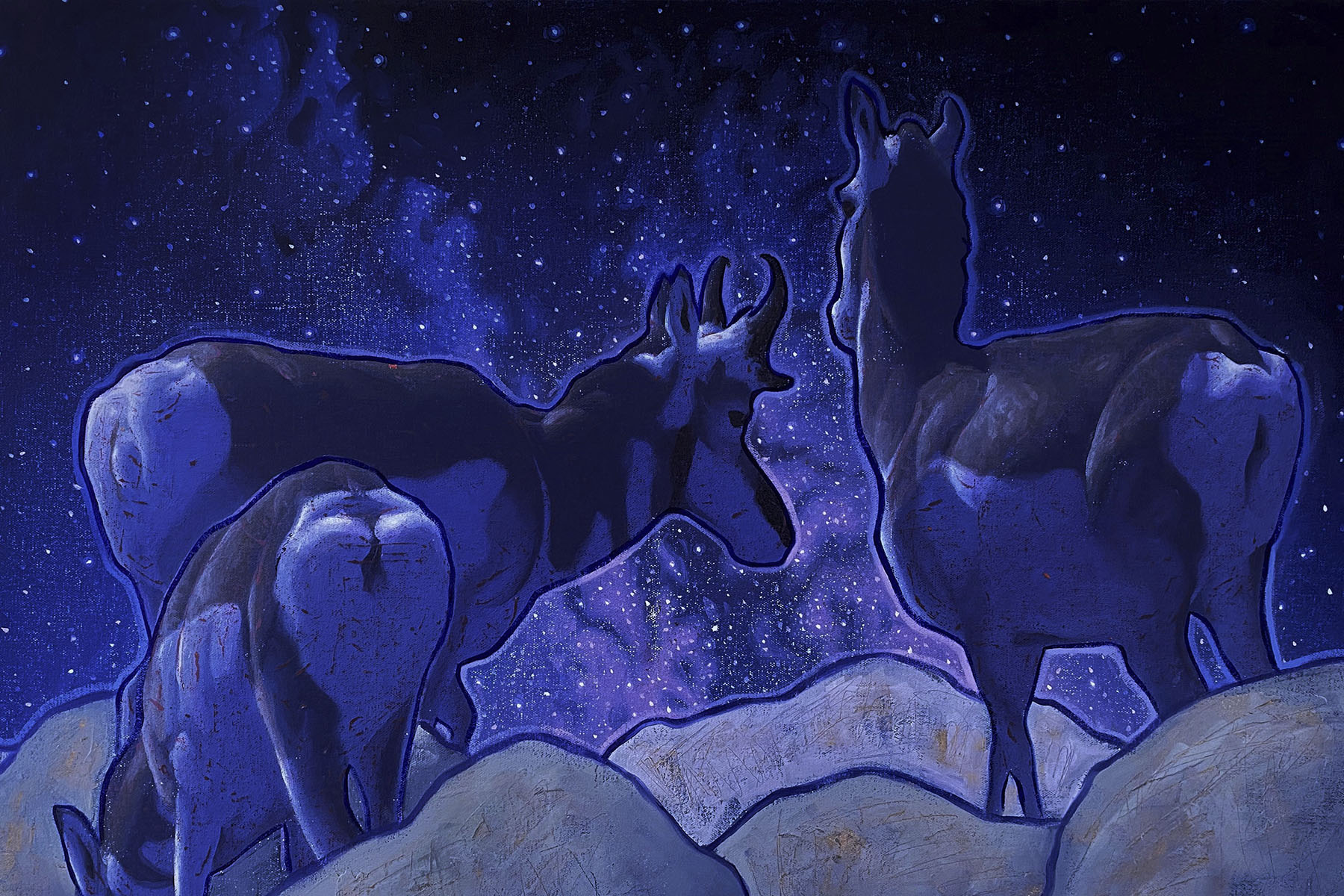Nick Thornburg: What has changed for you in the last several months, between the release of your Featured Artist article and now in early February?
Luke Anderson: In the past year I think that my fundamentals have been the thing that have changed and improved the most, oddly enough.
NT: Is that something you were deliberately focusing on?
LA: Yeah. When the pandemic hit I ended up having a three month hiatus from my second job. I sat down and created a plan to work on a few specific things I thought I was able to hide with others things or in other areas—these shortfalls. So I sat down and reevaluated how I draw, how I construct a painting in terms of an archival nature, building a painting correctly, using mediums as they’re intended, things like that. I think a lot of times when you’re pursuing a career, it’s easy to follow the momentum where it goes and ride the things that are working and push other things to the side and hope they don’t catch up with you at some point. So when I had the chance for a break I sat down and was like, ok, you gotta get better at these things.
NT: I think that’s an important point, because it’s really easy for people to get caught up in riding the wave they’re currently on and lose sight on how’d they’d actually want their art to progress over time. Do you think that hiatus and the pandemic-related break was a kind of blessing in disguise, giving you that breathing room?
LA: Yeah, I think so. I think a lot of artists faced the pressure of, oh, you have all this time now so you should be making your masterpiece now. That’s a lot of pressure to put on yourself in a really, really weird time. And so that was specifically why I didn’t set out the goal, oh, I’m going to paint this really big painting during this time. I was like, I’m going to do a bunch of little throw away things, really low-stake, and it doesn’t matter what happens to them. And I wouldn’t have been able to do that with a specific focus on improving myself if I didn’t have that extra time. Because when you’re not a full-time artist you have to negotiate with yourself how you can spend your time. Certain things get prioritized and certain things don’t. It’s especially hard to be critical of yourself and improve when you’re dealing with those momentum waves and time constraints that both funnel you into a certain way of working. It can be hard to break habits that way.

NT: Coming out of this period do you think that is something you’ll fold into your practice more consistently over time? Will you take more deliberate steps back to reevaluate and go back to fundamentals that you think you need to work on?
LA: Yeah, for sure. I feel like there are some useful analogies between art —or any skill —and professional athletes, who are really, really dedicated people who put in the work with the intention of always finding a way to improve. Knowing yourself and your own habits and rhythms, and being able to plug certain things in certain times or being able to restructure your day just to make time—my concept of being able to make the most of my time [used to be] just get up, eat breakfast, and then immediately sit down at my easel and start painting. Then I’d paint all day, eat dinner and go to bed, which is a good way to get a lot of paint on the canvas but not a great way to get great paintings, necessarily. I think it starts with expectations, changing what you can reasonably expect from yourself in a day or a week, and just adding in time for sketching, drawing from reference, basic organization and studio cleaning, reading, and other mentally engaging activities that aren’t necessarily focused on art. I think it’s easy to beat that dead horse without getting anywhere. It’s good to have a mental break that can take you to other places.
NT: To relate back to your sports analogy, what that seems to reveal —at least to my mind —is that there is a cyclical process to creativity, learning, and development. In sports there is time for athletes to deliberately recover, and that recovery period is considered an important part of training and preparation because it allows the body to heal but also allows the brain to ingrain things the athletes have learned in practice. In creativity it seems to be the same. There are periods of time when the work and the research and the deep-dive is really important, but that rest period, or incubation period, is what allows ideas to foment and allows realizations to come to the fore so that one can actually benefit from that hard work. So, working non-stop doesn’t seem to be the best way to pursue anything, I suppose, because that rest period is required.
LA: Yeah. It is something that I openly struggle with and that I have to fight with myself about. I’m one of those people who, if I have a problem, I have a really hard time moving onto something else, letting it go for a bit. I like to just sit down and work at it until I figure it out. I don’t know what the implications with that are, but that’s something I struggle with, to be able to step away and chill for a while and come back with fresh eyes. Usually that in itself helps.

NT: What would you say that’s related to? Where is that requirement coming from?
LA: I don’t know. I consider myself a problem-solver. I’ve always been skilled at problem-solving, and that’s so much of what painting is. I’ve always had some sort of expectation for rapid movement and development of things, and when that has to slow down that can be tough for me. That’s another thing, trying to get to know yourself —and that’s not necessarily art-related but life-related —that process of being introspective and figuring out how you can improve as a person generally translates to whatever your professional goals are as well.
NT: For sure. What you do for a living is such a small part of who you are as an individual. I guess it is a little surprising that we don’t spend much time thinking about those aspects of ourselves, as far as how to construct a better internal world that allows us to go about our day in a more productive and fulfilling way.
LA: Yeah. This is pretty broad, but I do think it goes back in part to how our culture thinks about education and how we’re ingrained with certain thoughts and habits about the careers we get into and how we’re supposed to think about work. There’s no conversation or education around balance or presence or introspection. They’re not core subjects in school. You’d be hard-pressed to find a class on introspection in any highschool classroom today.
NT: Right. You’re not going to find anything like that, aside from some philosophy credit in higher education, and even that’s a bit of a throwaway unless you’re studying philosophy as your main subject. I think this is something that illustrates the problems with hustle culture, which our generation is being served —but it doesn’t seem to be serving us in the way it proposes. Many people are just taught to rush, rush, rush, work, work, work. But are those efforts you’re putting in the most efficacious or the most fulfilling? Those are not the questions people are asking. They’re just following the program of hustle without putting in the time for introspection or deep insight and learning that allows them to do good work while also finding that sense of fulfilment. I feel like the arts are falling into that rhythm, especially if you’re one to pay attention to social media. Everyone on Instagram, for example, has this pressure to produce content, to show content, and that appears to be the end goal for most people.
LA: You’re absolutely right. I could rant for an hour about social media. There clearly seems to be a shift going on. Art is more open to anybody that it was before as being a vocational opportunity because of the internet and social media platforms. But the concept behind being successful on social media is not to get lost among everybody else, and the best way to do that is to post all the time. And so that absolutely drives the pressure to produce something —which, maybe there’s an argument as to why that’s good, because it forces us to explore avenues we might not otherwise have—but I would argue it’s probably doing more harm than good.
NT: Related to that, you have taken several breaks from social media in the past year. Not lengthy breaks, but deliberate breaks. How did you come to decide to do that?
LA: A lot of it comes to concerns that I have with myself when I start to assign too much self-worth or creative-worth to either my reception among my audience or comparisons with my peers and other artists. Usually there’s this moment where, if I find myself scrolling and I’m comparing my work to another artist’s too directly or thinking about their accomplishment that they just shared —if I catch myself doing that I’m like, that’s bad, I need to get away from this for a while. That’s usually where it comes from. A lot of it is I don’t like that feeling of putting on a show or allowing my artistic vision to be driven by something that’s external. That’s when I realize it’s time to take a break.
NT: That’s a good idea. I think more people ought to take those things into consideration. Back in your Featured Artist article, you said to take career advice “with a grain of salt.” And I think these things are related. You seem to have an ability to recognize something that you’d like to change, and you make the effort to do that, whereas so many other people simply allow things to play out according to a preconceived pattern or trend, while wishing otherwise. So what’s your secret sauce? Where does that ability come from?
LA: I think that some people are naturally more inclined to be that way, but that doesn’t mean everybody can’t be that way. I don’t know if there’s a secret sauce. I think you just have to come to a point where you can be frank with yourself and say, hey, this isn’t as good as it could be. And that may not be because of some external factor, it may be because of something you did or that you’re doing —but there are ways to remedy that. Because I was doing art on my own, I didn’t really have a community of artists that I could share with, so I was doing long form written critiques with myself of my own work. Sitting down and writing down things that worked and things that didn’t and things that could be improved. I think that was the starting point [for me] and I’ve just kept at it, and it has found its way not just into the end result but throughout the whole process.

NT: I guess if you’re committed to the process —or you’re committed to some form of growth —and you only have yourself, that could result in a radical form of honesty regarding oneself.
For other artists who are feeling the pressure of momentum or feeling the pressure of social media and they’re not feeling comfortable with the position that they’re in —they have some inkling that something needs to change—what is your suggestion to them?
LA: I would say if you don’t write or journal already, start doing that. Be really aware of all your commitments and which ones are the most important ones and which ones can be sacrificed. The greater goal is to be the best artist that you can be, and that’s not necessarily the same as being the most prolific artist. So I think it’s important to be able to sit down and recognize what is worth pursuing and what isn’t.
NT: There is light at the end of the tunnel. You just have to commit to making steps towards it.
LA: Yeah. And so much of this is in your own head. It’s mental. For me, getting that stuff out of my head and onto paper is helpful. For one, it helps me to avoid fixating on [problems] if I can get them out. It can literally feel like I’m pulling a thought out and putting it onto the page to come back to it later, freeing up some mental space. Because of that, I enjoy writing things down and journaling. It provides a nice record to refer back to, where I can see what things I was thinking about at what times of the year, and if I’ve improved on those things or if they’re still an issue.
NT: It’s a form of documentation. A tracking method.
LA: Exactly. It may be easier for some people to get into, those who have more of an aptitude or background in writing. It can feel weird at first for others, because you’re literally just rambling nonsense most of the time. But that’s kind of the point, and that’s okay. Visual art is obviously a visual medium, but even when we think about it and discuss it we distill it into language and words. So I think [writing] helps me with my work, and maybe even my broader vision for what I want to accomplish. Somehow, even if it feels like gibberish, it’s still helpful to try and work that stuff out with language.
Luke Anderson’s work can be found at Deselms Fine Art, Visions West Contemporary, Meyer Gallery, his website and on Instagram.
Support Regional Arts Coverage!
The Featured Artist and Conversations series were conceived as a way to showcase the stories of artists and creative people residing in the regional West while contributing to a wider conversation about creativity and the world of art.
To ensure this work continues, please consider supporting it.
Your contribution provides vital assistance and serves to demonstrate your appreciation for the work regional artists and creative people do to keep our communities vibrant and full of imaginative light.
If you enjoyed this arts coverage, donate below to keep the content coming! Learn more about becoming a supporter.
Become a Patron Without Spending a Dime. Learn More Here.
To be featured in an upcoming Featured Artist article or Conversation—or to nominate someone —please Contact Me.
Nick Thornburg is a multidisciplinary artist and writer. Follow Nick and share the work on social media. Subscribe to his mailing list to keep up-to-date with upcoming features and other news.
Stay Creative.
